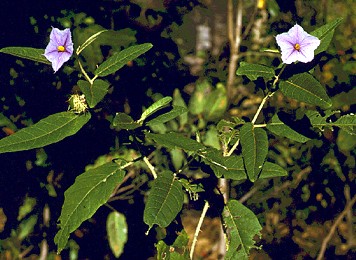
Synonymy
Solanum asymmetriphyllum Specht, in Specht & Mountford, Rec. Amer. Austral. Sci. Exped. Arnhem Land 3: 293; fig. 18 (1958)
T: Oenpelli, N.T., 6 Oct. 1948, R.L. Specht 1143; holo: BRI; iso: AD, CANB, K, L, NSW.
S. asymmetriphyllum var. longiflorum Specht, op. cit. 295.
T: Oenpelli, N.T., 6 Oct. 1948, R. L. Specht 1143A; holo: BRI; iso: AD, CANB, K, L.
Description
Erect, clonal shrub to 3 m, male or female, green, glabrous except lower leaf-surface which is densely pubescent with stellate hairs, upper surface almost glabrous; prickles to 8 mm long, sparse to common on calyx of female flower, sparse to absent elsewhere.
Leaves elliptic to ovate-elliptic; lamina 9-18 cm long, 3-7 cm wide, sometimes larger, discolorous, entire to shallowly lobed; petiole 1-2 cm long sometimes to 6 cm.
Male plant: inflorescence elongate, 40-60-flowered; peduncle 3.5-5 cm long; pedicels 5-8 mm long; calyx somewhat 2-lipped, 3-5 mm long, the lobes triangular, 1-3 mm long; corolla broadly stellate, 25-30 mm diam., purple; anthers 5-6 mm long. Fruiting plant: flowers solitary; pedicels 10-15 mm long; calyx 10-15 mm long, angular, enlarged in fruit, the lobes narrowly triangular with linear apices, 5-10 mm long; corolla rotate, 40-60 mm diam., lobes with linear apices 2-7 mm long, purple-blue; anthers 6-8 mm long.
Fruiting calyx 2-3 cm diam. Berry globular, 2-3 cm diam., shining green when ripe, drying black. Seeds 2.5-3 mm long, light to dark brown. n=12.
Description from Flora of Australia 29: 172 (1982).
Distribution and ecology
Occurs on north-western scarp of Arnhem Land Plateau, N.T. on rocky outcrops.
Relationships
All of the dioecious members of the Dioicum group of subgen. Leptostemonum exhibit functional dioecy i.e. male flowers are borne on separate plants from what appear to be plants with bisexual or hermaphrodite flowers; while these bisexual flowers do produce pollen, it is inaperturate and does not germinate, making the flowers effectively female (Knapp et al.,1998).
Initial molecular studies by Martine et al. (2006) suggested that the two functionally dioecious species from Kakadu, S. asymmetriphyllum and the newly described S. sejunctum, formed a separate clade and had arisen separately from the other dioecious members of the Dioicum group, S. cunninghamii, S. cataphractum , S. dioicum, S. petraeum, S. carduiforme, S. tudununggae, S. vansittartense and S. leopoldensis. T his initial DNA analysis involved sequencing of the ITS region of nuclear rDNA.
However further molecular analysis involving the trnK-matK gene region indicated that all of the functionally dioecious species form a single clade arising from the andromononoecious species of the group (Martine et al., 2009).
References: S.Knapp, V.Persson & S.Blackmore (1998). Pollen morphology and functional dioecy in Solanum (Solanaceae). Pl. Syst. Evol. 210:113-139.; Martine, C.T., D. Vanderpool, G.J. Anderson, and D.H. Les (2006). Phylogenetic relationships of andromonoecious and dioecious Australian species of Solanum subgenus Leptostemonum section Melongena: Inferences from ITS sequence data. Systematic Botany 31: 410-420; Martine, C.T., G.J. Anderson & D.H. Les (2009). Gender-bending aubergines; molecular phylogenetics of cryptically dioecious Solanum in Australia. Australian Systematic Botany 22: 107-120.
Notes
A functionally dioecious species (see Relationships).
It was recognised some years ago that collections from Radon Gorge and Mt Brockman represented a form which was more pubescent on the upper leaf surfaces than the usual S. asymmetriphyllum. The fruiting calyx was closely densely pubescent and the prickles shorter and more conical.
These specimens were segregated from the rest of the species in the Darwin Herbarium as Solanum A55445 "Mt Brockman".
These specimens have now been described as S. sejunctum q.v.
Selected specimens
N.T.: Red Lily Lagoon, East Alligator River, N. Byrnes 2715, 2716 (DNA); East Alligator River crossing, D.E. Symon 5154 (AD: 2 sheets, CANB, PERTH), 7173 (AD, CANB, NT); 11 km W of East Alligator River crossing, D.E. Symon 7178 (AD, BRI, MEL, NSW, NT).
Plant status, if any
Conservation status as a plant of least concern in the
From the web
According to the Fire Response Records of North Australian Land Manager, S. asymmetriphyllum has a life span of 4-5 years, seeding in its first year. It does not resprout, is mostly killed when subjected to fire and recruitment is by seed.






